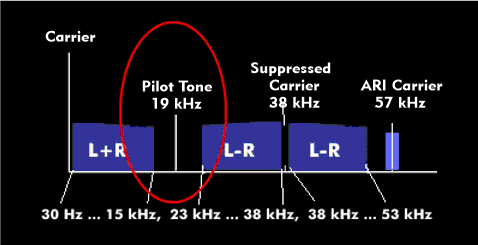pilot tone
Pilot tones are additional, control or monitoring signals which are transmitted in telecommunications and broadcasting technology in addition to the useful signals. They can have a wide variety of functions and can be used, for example, to control and monitor the characteristic values of the transmission link or as additional signals for modulations.
In carrier frequency systems, for example, a pilot tone with a frequency of 60 kHz is used, with a duration of one second. This pilot tone is used to detect disturbances in the transmission path and deviations in the channel characteristics.
The situation is different in VHF broadcasting, which uses a 19 kHz pilot tone. This pilot tone is used for the regeneration of the stereo subcarrier. With its frequency of 19 kHz, the pilot tone lies within the FM transmission range, but is no longer audible.
By frequency doubling, the carrier frequency of 38 kHz is obtained from the pilot tone, which is added to the amplitude-modulated difference signal from the left and right stereo signals (L-R). This measure is necessary because the (L-R)signal is transmitted in amplitude modulation with suppressed carrier frequency. Only by adding the carrier can the (L-R) signal be demodulated.
In addition, the pilot tone is used for stereo display on the broadcast receiver.

